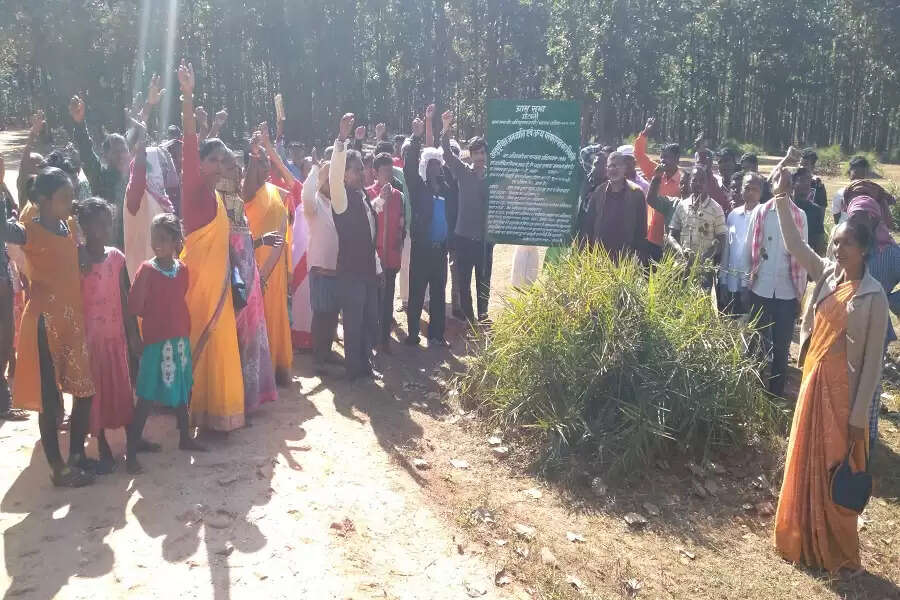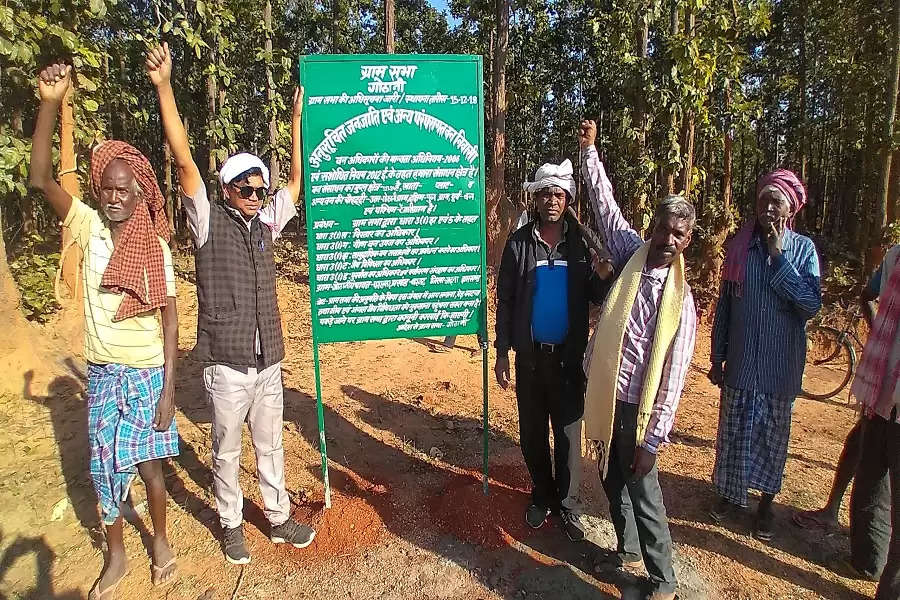-
In tribal Jharkhand, people lay claim to their forest rights — one way or another
 With forest rights being a sensitive subject in the state, signboards are now becoming a novel way for tribal communities to claim what they are due.Ranchi: “In the three villages where signboards have come up, villagers possess community rights to 1,100 acres of land under the Forest Rights Act, 2006. There’s now a plan to set up signboards in other villages in Garhwa district. With these signboards, the gram sabha will ensure the management, protection and conservation of that forestland,” says social worker Sunil Minj.
With forest rights being a sensitive subject in the state, signboards are now becoming a novel way for tribal communities to claim what they are due.Ranchi: “In the three villages where signboards have come up, villagers possess community rights to 1,100 acres of land under the Forest Rights Act, 2006. There’s now a plan to set up signboards in other villages in Garhwa district. With these signboards, the gram sabha will ensure the management, protection and conservation of that forestland,” says social worker Sunil Minj.
With his statement, Minj explains how tribal communities in Jharkhand’s Garhwa district — yet to get their claims under the Forest Rights Act (FRA) — are asserting their right to forestlands; they are now setting up signages.
The first boards were set up in February in three villages of Bargad block: Baadikhajuri, Kaalakhajuri and Gothani. Villagers, who held detailed discussions on the matter, assert that their campaign is constitutional, and they have legal rights under the FRA, which they emphasise on the boards.
Speaking to 101Reporters, Amos Minj, the sarpanch of Gothani village, recalls, “It was on December 15, 2018, that we submitted a claim to community rights for 117 acres of forestland. Till date, we have not received the land rights certificate. Thus, utilising the authority that gram sabhas are granted under the FRA, we set up these signboards in Gothani.”
Jay Prakash Minj, the central president of the Akhil Bharatiya Adivasi Mahasabha, echoes Amos’ sentiments.
“People in our village have been fighting for forest rights over the past 25 years. Claims to community rights were submitted years ago, but the administration’s negligence has stalled the process. The gram sabha was forced to install signages to claim their rights to the forestland. Boards are erected only on those lands for which we had made claims earlier," says Minj, whose organisation has been dealing with issues related to the FRA since 2017.
What the boards convey
The signboards declare that the panchayat mentioned falls under the FRA, and that traditional dwellers have the community rights to the area. They also assert that without the permission of the gram sabha concerned, any deforestation, smuggling of forest resources or harm to the local biodiversity would be dealt with legally.
According to villagers, the administration has sought to halt the campaign, assuring the protestors that land rights certificates would be distributed within two months. This assurance was given back in February; five months on, there appears to be no progress in this regard.
However, officials contradict the villagers’ claims. Ramnarayan Singh, the sub-divisional officer (SDO) of Ranka in Garhwa district, says he never promised they would hand over land rights certificates in two months.
"Yes, I had guaranteed a discussion on the issue, but it could not happen due to the panchayat elections here," he explains. "The issue will be taken up by the deputy commissioner, and a decision will soon be made on land rights certificates.”
Why land rights certificates matter
To understand the significance of forestland rights, it is important to look into some key numbers. As per a 2019 survey conducted by Jharkhand Van Adhikar Manch and the Indian School of Business, 14,850 of the 32,112 villages in Jharkhand fall under forest areas. Forest villages cover over 73.9 lakh hectares, with a population of around 2.5 crores. Of this, 18.82 lakh hectares can be claimed under the FRA for community and personal rights.
The three districts of Palamu division — Garhwa, Palamu and Latehar — have 3,492 villages, of which 2,009 fall under forest areas. In this region, claims to around 4.6 lakh hectares can be made under the FRA.
Organisations like the Jharkhand Jungle Bachao Andolan say that at least 75 lakh people depend on forests in the state, as a result of which it is imperative that land rights certificates be handed over to them.
Dilly-dallying by officials
Looking at the official numbers for recipients eligible for forestland rights in Jharkhand, one can get an idea of the administrative lethargy over the issue.
As per a report available on the website of the Ministry of Tribal Affairs, till March 31, 2022, the Jharkhand government distributed land rights certificates only for 2.5 lakh acres of forestland; it received over 1.1 lakh claim forms, of which certificates were for 61,970 claims.
Moreover, the issue of forest rights has always been a political hot potato in the state. Interestingly, the Jharkhand Mukti Morcha (JMM), which currently heads the state government, was vocal on the subject when it was in the opposition in the state assembly. Ahead of the 2019 elections, the JMM had made assurances over land rights certificates to tribal and other forest-dwelling communities. The then opposition had also promised to make the filing of claims and receiving these certificates more convenient.
‘How many have received land rights?’
Mithilesh Kumar, who works for the Jharkhand Van Adhikar Manch in Palamu block, tells 101Reporters, “Community land rights are not being given, nor is the government showing any will to do so. Implementation of the FRA, too, is lacking. If all of this had happened, we’d not have seen villagers setting up these signboards.”
“The FRA was implemented in 2008 in Jharkhand; we are now in 2022. How many have received their land rights certificates till date?”
“Tribal communities have had a stake in the forests since time immemorial, but the government is reluctant to accept the fact.”
“They want to give the land to corporates and are doing so, as well,” Kumar adds.
According to several volunteers with the Jharkhand Van Adhikar Manch, the administration is associating the signboard campaign with the Pathalgadi movement, a resistance campaign by the tribal communities in Jharkhand’s Khunti district, which they believe is an attempt to suppress the drive.
“It is not illegal to set up signboards in the forests. It is, in fact, permissible under sections 3 and 5 of the FRA,” stresses Mithilesh Kumar of the organisation.
When 101Reporters enquired about these claims, Ranka SDO Ramnarayan Singh responds, “We do not see anything unconstitutional in the campaign, so far. I cannot comment on whether we will try to stop it in the future.”
Meanwhile, Kumar alleges that the forest department has been harassing villagers over land rights.
“The forest department is digging trenches on community forestlands, to which villagers have legal rights. They plant trees in these trenches that, in a way, mark the limits of the forestland on which villagers can stake their claim,” he explains. “If villagers cross these boundaries to fetch firewood or beedi leaves, the forest department files a case against them.”
According to Land Conflict Watch, an organisation that maintains a database on land conflicts in India, there has been an increase in the number of new conflicts since June, with their database currently tracking 621 ongoing disputes.
Incidentally, on June 28, the Ministry of Environment, Forest and Climate Change had notified the Forest Conservation Rules, 2022, under the Forest Conservation Act, which replaced the earlier rules notified in 2003.
Under the new rules, any “diversion, assignment of lease or de-reservation” (use of forest land for non-forest purposes) after receiving ‘final’ approval from the central government under section 2 of the act, can take place after the state or union territory issues an order following “fulfilment and compliance of the provisions of all other acts and rules made thereunder”. These include the settlement of rights under the FRA, 2006.
However, the updated rules may prove to be more of a bane than a boon, according to Satyam Shrivastava, a member of the committee set up by the Ministry of Tribal Affairs on habitat rights and community forest rights.
“The FRA, 2006, was formulated to ensure that forest-dwelling communities serve as an interface between the government and the forestland. Their decision-making rights and consent to carry out a non-forestland diversion was acknowledged as crucial for forest conservation and governance,” he explains.
“The colonial legacy of diverting forestlands didn’t recognise the say of such communities that resided in and conserved forests through generations. Then came the FRA in 2006, to democratise the process, which empowered gram sabhas as statutory authorities to manage and conserve forests. The act mandates the recognition of community rights by law and their consent before the undertaking of any non-forest diversion of a forested area.”
Shrivastava cites a July 2009 forest ministry circular, which mandated that land diversion for non-forest purposes can only be undertaken following a resolution by the gram sabha. It must acknowledge that the FRA has been implemented in the region, granting the applicable rights to the community, before granting the in-principle clearance.
“Ultimately, land conflicts will rise further if consent from gram sabhas is not sought at the primary stage,” he warns.
This article is a part of a 101Reporters' series on The Promise Of Commons. In this series, we will explore how judicious management of shared public resources can help the ecosystem as well as the communities inhabiting it.
Edited by Sharad Akavoor
All photos: Md. Asghar Khan(The author is a Odisha-based freelance journalist and a member of 101Reporters, a pan-India network of grassroots reporters.)
